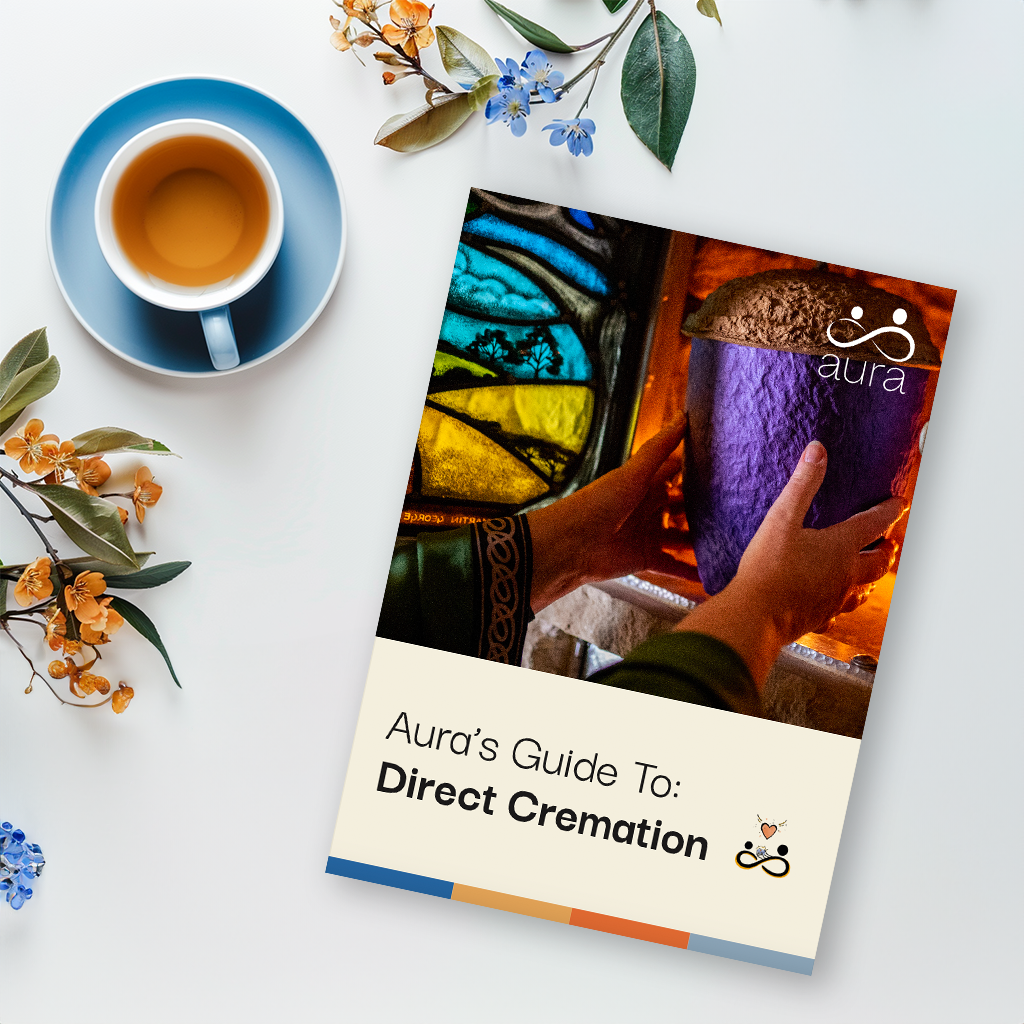




Written by Emily Cross.
18 minute read
Most funerals, memorials, and ash scattering ceremonies include flowers of some kind, though, of course, they aren’t necessary if not desired. They serve a variety of purposes, not least of which is adding a sense of ceremony to the occasion and acting as a tribute to the person who has died. There are many different types of arrangements suitable for a funeral, and while there are flowers deemed traditional for the occasion, mourners may wish to choose any they feel are appropriate.
Arranging a funeral can feel overwhelming, especially during a time of grief, but we want to help change that with a kind, compassionate approach. Everyone here at Aura stays true to the family-run ethos created by our founder, and it’s something that can help you find a path forward in your own personal way.
We hope that you find some sense of support and some new ideas that will help you make choices that you feel comfortable with. We are always right here when you need us.
Key takeaways:

Funeral flowers have been used to honour loved ones for centuries and are used as a sign of respect, as well as a token of sympathy and well wishes to the family. They’re one of the most common items on a funeral checklist, and for good reason. From an aesthetic point of view, floral arrangements can add beauty and a sense of peace to the funeral environment, offering comfort to mourners.
Flower arranging is a type of artistry, and as such, florists are able to create floral tributes of all colours, sizes, and shapes, such as sympathy wreaths, casket sprays, names, crosses, and hearts. There are also meanings attached to the type of flower itself, varying from traditional funeral flowers such as the lily to more exotic choices, which may be chosen for their significance to the person who has died.
Different types of funeral flowers are used for different purposes, with different meanings, and by different people. When considering funeral flower etiquette, there are some common arrangements you may wish to look at, yet even these can vary drastically from piece to piece, depending on flower choice, colour, and flower placement.
When it comes to funeral flowers, wreaths are perhaps the most traditional floral arrangements; their circular shape has no beginning or end, symbolising endless love and devotion, as well as the circle of life itself. The flower wreath at a funeral is often placed on the coffin. White lilies are classic additions to the wreath, along with red roses and white chrysanthemums. Of course, funeral flowers are a personal decision, and many decide they wish to move away from traditional choices and choose something that has a special meaning for them. You may also wish to add greenery or decide on different colour schemes so that you find something that you feel represents your loved one.
The coffin spray is a large arrangement that sits on top of the coffin; as this spray is so close to the person who has died, it may often be chosen by the closest loved ones who are arranging the funeral. There are two types of coffin spray: single-ended and double-ended. The single-ended spray takes a teardrop shape, whilst the double-ended is diamond-shaped. Whilst traditional flowers are often used for sprays, so are personal choices and individual colour schemes. Sometimes, coffins are adorned with the title of the person who has died, such as Mum or Dad, rather than a spray, if you so wish.
A standing spray is traditionally a teardrop-shaped arrangement that is hung near a memorial table or coffin. These can be made up of a choice of flowers, or a simple traditional scheme can be chosen; often ribbons are added to suit personal tastes and preferences. Crosses and hearts are also popular, with crosses traditionally reserved for those of religious backgrounds, representing Jesus Christ and the promise of eternal life, and hearts often chosen by those closest to the person who has died, signalling the honouring of a loved one. The point here is that although there are many traditions and options, everything is deeply personal and ultimately up to you.
Different flowers carry different meanings, having been used for centuries to symbolise different things. There is no right or wrong when thinking of funeral flower ideas; they may be chosen for their traditional meanings or simply because it was a favourite flower or colour of the person who has died. Flowers have been chosen for all kinds of reasons, from customary significance to the matching of a favourite football team’s colours.
Different cultures may interpret different meanings from flowers. For example, in Chinese culture, chrysanthemums represent nobility rather than sympathy, while in Ancient Rome, lilies weren’t a symbol of peace but of love. In Victorian England, tulips were the flower of passion instead of a sign of new beginnings. At the same time, carnations represented rejection and heartache, as well as also holding the same meaning of remembrance as they do now.
When choosing flowers for a funeral, ash scattering ceremony, or memorial, you may wish to consider personal meanings as well as traditional ones. Favourite flowers of the person who has died are a good place to start, if they had one. You could also bear in mind their hobbies and interests, as well as personality traits or personal traditions. Perhaps you gave them red roses every anniversary, or maybe spring was their favourite season and tulips may feel appropriate. If your loved one was known for their elegance, irises could be perfect; if infectious happiness is a trait you associate with them, daisies or sunflowers may be worth consideration. Likewise, a creative artist might be suited to the vibrant marigold. Sometimes, it can help to sit and reflect on their life and how they lived it before you consider flowers.
In addition to the symbolism of particular flowers, colour is another theme to consider, as it can cover many different moods, personality traits, and emotions. Here are some ideas that may serve as a starting point once you are ready:
Traditional colours are one way to choose the colour scheme of a funeral flower arrangement, whilst the personality and tastes of the person who has died may also serve as inspiration. If their favourite colour in life was yellow, why not surround them with it in death? Likewise, if they were thought of as elegant and graceful, pink might be your colour of choice. Religious beliefs may also influence your choices. Christians may wish for lots of white, for its representation of rebirth and resurrection, and Buddhists may prefer it for its link to peace but may choose to avoid the colour red. In large parts of Asia, yellow is a favourite colour for funerals, and in Hinduism, there is a tendency towards the bright yellows and oranges of marigolds. There are no right or wrong options here, only choices that you can consider when the time feels right.
Funeral wreaths in the UK come in various shapes and sizes. Which flower wreath a mourner will choose depends on taste, personality traits of their loved one, culture, and religion.
The traditional circular wreath is a symbol of eternal life due to the never-ending nature of the circle. A heart-shaped wreath signifies love, particularly either romantic love or the love found in a close relationship, so it is usually chosen by a spouse or immediate family member. A letter wreath tends to spell out the name or family title of the person who has died, for example, ‘Lee’ or ‘Dad’. For this reason, it is most commonly chosen by a family member.
Ribbons may also be tied across wreaths, spelling out a message. Common words or quotes used include:
‘Remembered and in our hearts’
‘Gone but never forgotten’
‘Rest in peace’
‘Forever in our hearts’
While costs for funeral wreaths will vary somewhat across the UK, as a guideline, you can expect prices start at around £40-50 for a small wreath for a funeral and can go up to over £150. Interflora lists funeral wreaths priced between £80 and £195, depending on the design and floral selection
Prices will depend on the size of the wreath, the types of flowers and their quantities used, how much greenery is used, and the intricacy of the design. Another influence on pricing will be how much customisation is required, such as extra flowers, ribbons, and messaging. It is important when budgeting to factor in florist delivery costs too, which can potentially be upwards of £20.
Funeral and memorial flowers aren’t limited to the ceremonies themselves. Also to consider are arrangements for both the hearse and the graveside, which can be similar to the funeral floral pieces or completely different, or even have duplicate uses.
Funeral hearse flowers tend to be large, significant pieces that can be easily seen from outside. They may include a coffin spray, which remains on the coffin for the service, and funeral letters, popular personal tributes that can be used for the service only or accompany the coffin in the hearse. Wreaths, being the most common funeral flower arrangement, are also often seen in hearses.
Mourners tend to include flowers in the hearse for the same reasons they use them in a service – as a token of respect and mourning and to honour the person who has died; using them in the hearse ensures that the person who has died is accompanied by these tributes at all times on their journey. Personalised hearse flowers might include favourite flowers, colours of particular significance, and personal messaging, such as on ribbons or via funeral letters. Mourners might consider the preferences, personality, and culture of the individual being buried or cremated.
Just as with using flowers during the funeral, memorial, or ash scattering ceremony, we traditionally place floral arrangements at the grave or burial site with the purpose of honouring the person who has died, expressing our love and grief, and as a visual comfort for those in mourning. When we use flowers, colours, or arrangements with particular meanings attached, this can add to our sense of peace and comfort as we grieve. As time goes on, leaving flowers as a tribute to the person who has died is a way of marking their death on an ongoing basis and can feel like an act of gift-giving even now the person has died.
Wreaths and sprays are popular choices, as are standard bouquets — if an individual is making regular visits to a grave, there is no pressure or expectation for them to bring an expensive floral arrangement every time. Some choose to bring a small bunch of flowers or even hand-picked wildflowers. What is important is the meaning that it gives to the mourner and what they feel it would have meant to the person who has died. This is something that is deeply personal for you and your loved ones.
For those concerned about the environmental impact of leaving wreaths with plastic elements that won’t degrade easily, there are biodegradable options available. A simple and easy option you may wish to consider is to take hand-picked flowers with no wrapping or to remove the cellophane and elastic ties from a shop-bought bouquet. Alternatively, florists offering biodegradable arrangements are becoming more common, and you can request that a tribute uses only natural structures and ties such as wicker and raffia. They should avoid floral oasis foam, wires, cellophane, containers, and vases.
Another way to help support and protect the environment is to use seasonal flowers. Tulips naturally bloom in the spring, whilst summer brings roses and sunflowers. Chrysanthemums, meanwhile, flower in the autumn, making them an ideal choice for the cooler months. Finding something that feels right is about taking your time and giving yourself space to think.
Some may find it upsetting if an expensive or carefully arranged floral tribute only lasts for a short time, so it may be of interest to look into the most long-lasting flowers available. Lilies and sunflowers tend to last 1-2 weeks, whilst carnations, orchids, and chrysanthemums can last upwards of three weeks. Another alternative that some choose is to use synthetic flowers, which will, if high quality, provide a truly long-lasting option you may wish to consider in a little more detail.
Whilst traditional funeral flower arrangements remain popular, more and more people are choosing modern alternatives. Environmentally friendly arrangements, where only natural, biodegradable materials such as wicker, twine, and raffia are used, are one such alternative.
When considering what to take to a funeral, potted plants make a lovely gift for your loved one’s nearest family or could be placed at the graveside itself, depending on what you feel comfortable with at the time. They could also perhaps be used at the service where mourners can take them home afterwards as a personal memorial. Memorial trees are another potential option that may serve the same purpose, and many consider them to be a wonderful way of keeping a more permanent tribute to the person who has died. With a little time and space, you will know what is right for you and your family.
Other options for decorating the funeral service include:
It is becoming increasingly common for the close family to request donations to a particular charity, perhaps one close to their loved one’s heart or one that provided care or assistance through the last months or years. These donations can be made at the end of the service or sometimes done online via the charity’s website and can help mourners pay their respects in a way that feels right to them.
We hope you have found some words of comfort and some ideas on how to move forward by reading our guide. What we have outlined are no more than traditions, conventions, and popular choices — you are never constrained to choosing from this list when you want to express yourself in your own personal way.
If you’re considering a pre-paid funeral plan, or are needing to arrange a direct cremation immediately and would like to talk to people who are kind, caring, and compassionate, we can help lighten the load of making funeral arrangements. It’s our way of helping you to keep moving forward in a way you feel comfortable with.

If you’d like more information about direct cremation and Aura’s funeral plans, then our downloadable guide can help. Find out why others are choosing this affordable, no-fuss alternative to traditional funerals and why it might be right for you too.
Download our guide by clicking the link below and learn more about this simple funeral plan option.
No, funeral flowers are not required. While they are a traditional way to honour someone who has died, they are entirely optional. Many people now choose alternatives like donations, photographs, or other personal tributes.
The most common arrangements include coffin sprays, sympathy wreaths, standing sprays, and floral crosses or hearts. Each serves a different purpose and can reflect different levels of closeness or symbolism.
Flowers have various traditional meanings. For example, lilies represent peace, red roses signify love and grief, white carnations represent purity, and tulips can symbolise new beginnings. Some families also choose flowers based on personal significance or memories.
Think about their favourite flowers, colours, or even hobbies. Bright colours may reflect joy and energy, while elegant flowers like irises might suit someone known for grace. Consider what would have felt right to them or what feels right to you when remembering them.
Traditional colours include white (peace and rebirth), deep red (grief and love), purple (mourning), and green (life and renewal). However, any colour that holds meaning for you or reflects the person’s character is appropriate.
Prices vary, but most funeral wreaths range from £40 to over £150 depending on size, flower types, and design complexity. Some florists charge extra for delivery, so it’s helpful to check in advance.
Yes, many people include floral arrangements in the hearse and at the graveside. Coffin sprays, letter tributes (e.g. “Mum” or “Dad”), and wreaths are all common options for these moments.
Yes. You can request biodegradable arrangements made with natural materials like wicker and raffia, and avoid plastic or floral foam. Seasonal flowers and hand-picked wildflowers are also gentle on the environment.
Alternatives include potted plants, memorial trees, charitable donations, and personal items like photographs, soft toys, or hobby-related objects. These can feel just as meaningful and may be better suited to your loved one’s personality.
Give yourself time and space. Reflect on the person’s life, what they loved, and what would honour their memory best. Whether you choose traditional flowers or a more personal tribute, what matters most is the meaning behind it.